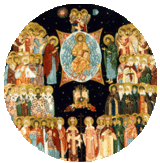Reformation or All Saints
October 09, 2006
 Each year we come to the end of October and the planning calendar reminds us that “Daylight Savings Time ends”! But more importantly the calendar will also remind us that the last Sunday in October is “Reformation Sunday”. However, a closer look will reveal that October 31 is “Reformation Day” (not Halloween on the Church calendar) and November 1st is “All Saints’ Day”. What is a church to celebrate? This year “Reformation Sunday is October 29th” and the next Sunday is not All Saints but “Christian and Citizen” Sunday. Of course, in a perfect world, we would celebrate the Reformation on October 31st and All Saints on November 1st. However, it is not always easy to get people to come to church during the week (as we observe during Holy Week). I admit, Christmas is an exception, but then again even the culture has consumed this holiday!
Each year we come to the end of October and the planning calendar reminds us that “Daylight Savings Time ends”! But more importantly the calendar will also remind us that the last Sunday in October is “Reformation Sunday”. However, a closer look will reveal that October 31 is “Reformation Day” (not Halloween on the Church calendar) and November 1st is “All Saints’ Day”. What is a church to celebrate? This year “Reformation Sunday is October 29th” and the next Sunday is not All Saints but “Christian and Citizen” Sunday. Of course, in a perfect world, we would celebrate the Reformation on October 31st and All Saints on November 1st. However, it is not always easy to get people to come to church during the week (as we observe during Holy Week). I admit, Christmas is an exception, but then again even the culture has consumed this holiday!
***
During the period of the church calendar between Trinity Sunday and Christ the King, All Saints is our only feast day. It is also the time of the year when the harvest is beginning in the northern hemisphere. During the harvest images of abundance and feasting begin to appear. This is also the time when we celebrate those who have completed their baptism (those who have died) and celebrate with joy the communion of saints with whom we raise our voices in song at the Lord’s Table each communion (…we raise our voices with the choirs of angels and the faithful of every time and place who forever sing to the glory of Your name... –Great Prayer of Thanksgiving). The feast of All Saints reminds us that our baptism is a life-long journey and that we are joined with those who have completed their baptism (died in the faith) in the mystery of the sacrament of communion. And this is a foretaste of that ultimate banquet feast to come! When the ultimate harvest is complete! Baptism and Eucharist are the primary symbols of this feast day. The symbols of water, wine and bread should be present and engaged each Sunday. However, on this day we celebrate how they join us as one community across time and space. We are reminded that nothing in life or in death can separate us from the love of God in Christ. It is through baptism that we enter the church and only in death is our baptism complete. At the table we are joined with Christ, one another and the faithful of every time and place.
One of the key changes sought after by the Reformers was a reclaiming of sacramental practice that involved the gathered community of faith. Giving communion back to the people and making baptism an act done in public with the congregation were important pieces of the Reformation. In a time when our church is also reclaiming a more frequent sacramental practice, the celebration of Reformation Sunday as also a the Feast Day of All Saints may be a powerful way to celebrate and connect baptism and the Lord’s Supper. In Call to Worship, Year B, vol. 39.1, there are liturgical resources for each Sunday as well as feast days. There is two pages dedicated to All Saints’ Day (pp.198-199) that can be helpful in constructing an All Saints’/Reformation Sunday. Also the Book of Common Worship, p.385-391, is dedicated to this Feast Day of All Saints’. If you are not planning a special Feast Day celebration on November 1st then you may consider using this material to celebrate All Saints’ as well as Reformation Sunday this year.